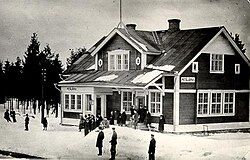Electoral districts
Following the electoral reform to the new Parliament of Finland in 1906, the province was divided into an Eastern and a Western electoral district.
Western electoral district
Haapasaari, Hamina, Johannes, Kanneljärvi, Koivisto, Koiviston maalaiskunta, Kotka, Kouvola, Kuolemajärvi, Kymi, Lappee, Lappeenranta, Lauritsala, Lavansaari, Lemi, Luumäki, Miehikkälä, Nuijamaa, Pyhtää, Savitaipale, Seiskari, Sippola, Suomenniemi, Suursaari, Säkkijärvi, Taipalsaari, Tytärsaari, Uusikirkko, Vahviala, Valkeala, Vehkalahti, Viipuri, Viipurin maalaiskunta, Virolahti, Ylämaa.
Eastern electoral district
Antrea, Harlu, Heinjoki, Hiitola, Impilahti, Jaakkima, Joutseno, Jääski, Kaukola, Kirvu, Kivennapa, Korpiselkä, Kurkijoki, Käkisalmen maalaiskunta, Käkisalmi, Lahdenpohja, Lumivaara, Metsäpirtti, Muolaa, Parikkala, Pyhäjärvi, Rautjärvi, Rautu, Ruokolahti, Ruskeala, Räisälä, Sakkola, Salmi, Simpele, Soanlahti, Sortavala, Sortavalan maalaiskunta, Suistamo, Suojärvi, Terijoki, Uukuniemi, Valkjärvi, Vuoksela, Vuoksenranta, Äyräpää.

























